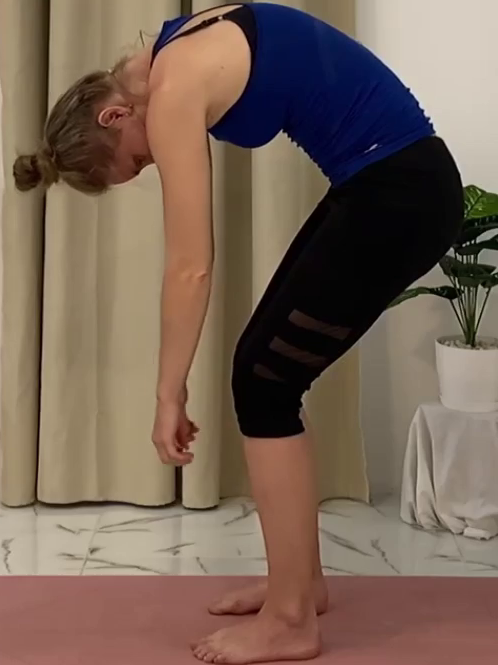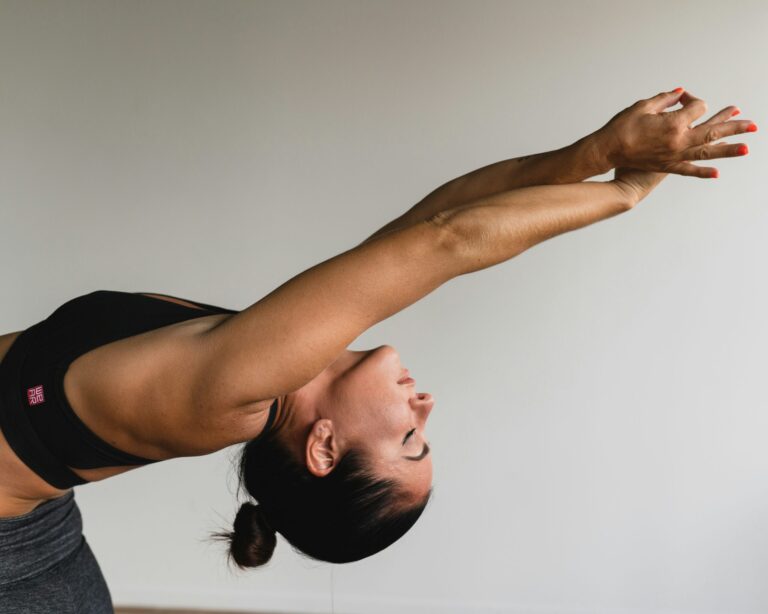Standing forward bend in yoga: should you lengthen or bend your legs?
A Biomechanical Guide to Safe Bending Forward for Yoga Teachers and Practitioners
Introduction
Namaste dear yogis and yoginis!
Today, we delve into the intriguing topic of standing forward folds and their impact on our and our students' posture. As a yoga teacher or practitioner, you may have encountered the leg length dilemma during standing forward folds. Should you fully lengthen the legs or bend them? And if you bend them, how much? Does micro-bending the knees in a forward fold really keeps you safe?
In this article we will explore the different positions and you will understand why neither straightening nor micro-bending is a real solution for healthy forward folding from a biomechanical point of view. . Join me, Dr. Mareike Engel, as we uncover the secrets of optimizing forward folds to maximize your physical benefits.
Uttanasana Alignment according to B.K.S Iyengar ( (see „Light on Yoga“, p. 90)

The standing forward fold, Uttanasana (Uttana = deeply stretched, asana = pose), is a fundamental yoga pose that is practiced often as a held position but also as a transition during sun salutations for example.
Traditionally, from the alignment taught by B.K.S. Iyengar, the instructions to lengthen the legs by lifting the knee caps up and tilting the pelvis forward is prevalent in order to stretch the hamstrings. Learn why this alignment is not suitable for a regular yoga practice.
Why is it harmful to fully lengthen out the legs in a standing forward fold?
When going into Uttanasana with straight legs, the hamstrings get stretched out once the pelvis tilts further forwards then the resting length of the hamstrings allow. This leads usually to quite a strong sensation for the yoga practitioner that is most often perceived as nice, positive and beneficial for the body.
When this is done on a regular basis, however, the hamstrings are likely to adapt their resting state to a longer position than before. Once this happens, the pelvis will be in more of an anterior pelvic tilt, because the longer the resting state of the hamstrings (which attach to the sit bones) is, the less they are pulling the pelvis backwards (out of an anterior pelvic tilt).
Considering, that our modern lifestyle consists of prolonged periods of sitting, not enough movement in general or very repetitive movements (yoga, sports, gym, etc.), stress and trauma, we are already likely to end up in an anterior pelvic tilt (shortened, tight hip flexors, long usually weakened hamstrings) even without doing any yoga. Therefore, adding the regular stretching of the hamstrings in yoga, will worsen the anterior pelvic tilt and lead to a stronger lumbar lordosis (arching of the lower back). The strong lordosis is usually the visible sign of an anterior pelvis tilt. For yoga practitioners, this usually means that they can often easily reach their palms to the ground because they already start in a position where the pelvis is tilted forwards. The devastating truth is the following: The deeper you can bend down in a standing forward fold, the more likely it is, that you are ruining your posture.
If you now think that you are safe, since you don’t have a visible anterior pelvic tilt or since you can’t bend down much in a forward fold, wait! There is more to it! Unfortunately, having a flat lower back is in most cases an even worse position. A flat back is an anterior pelvic tilt that has additional layers of compensation. It occurs when the body can’t hold the pelvis in the anterior tilt anymore because the body would start to fall forwards. In order to “fix” this, the body rolls the pelvis under the torso (sometimes done consciously by sucking the belly in). This creates a flat lower back and a constant slight bend in the knees even when the person is really trying to fully lengthen out the legs.

In this case, typically, you might falsely believe that you really need to work on lengthening of the hamstrings because of the missing ability to lengthen the legs fully. However, this approach doesn't consider that other muscles are responsible for holding the pelvis in this position. The hamstrings that start to be shortend are simply a consequence.

If you go into an even deeper level of compensation, you end up in a sway back position. Now the pelvis is tilted posteriorly, the lower back is usually pretty flat (not always) and the pelvis is pushed forwards to be in front of the heels and shoulder. This position is a little special, since here, the hamstrings (especially the upper fibers) will be in a shortened state and the psoas lengthened out. However, this is initiated from the glutes that pull the femur and pelvis closer together in an attempt to prevent the body from falling forwards too much. There are other factors, such as tight front abdominal muscles, weak obliques, tightness in the upper back and chest area involved, but I will keep this for a separate article.
The message for this article here is that tight hamstrings are not the reason people end up in a sway back position but that the hamstrings get tight in this position because of the tension from other areas of the body preventing the pelvis from tilting forwards.Usually, hamstring stretches are advised in case of a sway back position and I do believe that in some cases gentle stretching can be beneficial here, but as described above, the real culprits are other muscles. Considering that this position occurred because of the lengthened and usually weak hamstrings in the first place, lengthening the hamstrings is not the solution. Working on the reactivity of the hamstrings including strengthening and very gentle lengthening can be beneficial in my experience. There are other muscles that need to be addressed first in case of a sway back posture to restore better body posture. I will write a more detailed article about this another day. But the focus for someone in a swayback position will be more on restoring the rotational abilities of the pelvis and the rib cage.
No matter if you have a flat back, a sway back position or an anterior pelvic tilt, when you practice a forward fold in yoga, stretching your hamstrings will not be beneficial for your posture. It will only give you a short term release from hamstring tension. As a long-term strategy, strengthening the hamstrings and improving hamstring reactivity will help to bring the pelvis back to a more neutral position. Now that we know that fully lengthening the legs in uttanasana is not beneficial, let's have a look at gently bending the knees.
Is it better to micro-bend the knees in a standing forward fold?
Bending the knees gently while still tilting the pelvis forwards is often claimed to be a safer variation. And in a way it is, since it is reducing the stretch for the hamstrings especially for the lower fibers. However, there will still be a stretch for the upper hamstring fibers. Practiced in a very gentle way and with focus on properly orienting the toes and knees forwards and an even tilt, I do believe that this variation can be beneficial for someone in a sway back position who has a very flat lower back
But for everyone else, I do not recommend it as it is still a hamstring stretch. So, how to practice a forward fold in a physically beneficial way
What is the best way to practice a standing forward fold in yoga?
From a biomechanical perspective, , stretching the hamstrings is not beneficial for the vast majority of people. The asana name Uttanasana (Uttana = deeply stretched) indicates that the yoga practitioner should, however, find a deep stretch in this position. My suggestion is to stretch the lower back instead.
A stretch for the lower back in Uttanasan can be achieved by bending the knees strongly and tilting the pelvis as far backwards as you can in order to round the lower back. In this position, the lower and mid back muscles are lengthened out. Moreover, by tilting the pelvis backwards, you can achieve a hamstring engagement in this position. Therefore, you use Uttanasana now to strengthen the hamstrings instead of lengthening them which is crucial for most people to reduce back pain, improve mobility, and restore healthy posture.

Even for people with a sway back position, I do recommend this variation because, they need lengthening of the back muscles especially in the mid-back which is achieved in this position. The only difference I make is that I invite people with a sway back position to move more in this position by varying the bend in the knees and the tilt in the pelvis. The latter is usually compromised in the case of a sway back position and can be trained in an efficient way in Uttanasana with bent knees since the practitioner needs control of the leg and core muscles to slowly transition from an anterior to a posterior tilt of the pelvis and backwards which will vary hamstring length while still keeping them slightly engaged most of the time. This can be very helpful to restore hamstrings reactivity to reduce hamstring tightness.
What if I Don’t Feel a Stretch in the Back?
Very commonly, I hear students saying that they don’t feel a stretch in their back in Uttanasana even if they bend the knees and round the lower back. In case this is true for you, it is even more a sign most of the time, that this is a variation that you should incorporate into your practice. From my personal experience, I can say that not feeling a stretch is typically happening when we have been very tight in our back for a really long time. In this case, we might not be able to tilt the pelvis properly backwards to get a real rounding in the lower back. If this is the case, keep practicing and make sure to work on hamstring engagement and lower back release in other ways.
Here are only 2 example videos of something that you can do, to help your body open up. After a while, you should start to feel a stretch in your back as well in the described Uttanasana variation.
Conclusion
Practicing yoga asanas should be beneficial for our physical body. Looking at Uttanasana through the lens of biomechanics makes it clear that the emphasis of our forward folds shouldn't be on elongating the hamstrings, but rather on nurturing the lower and mid back's well-being. This can be achieved by generously bending the knees and tilting the pelvis backward through activation of the hamstrings and abdominal muscles. This, my fellow yoga practitioners might feel weird and even less efficient in the beginning (who doesn’t enjoy the sensation that comes along with a hamstring stretch?!) but will give you tremendous physical benefits, e.g. alleviating back pain, enhancing mobility, and restoring an overall better posture reducing/preventing pain in other body parts.
My invitation for you with this article, especially if you are a yoga teacher, is to be open about experiencing the classical yoga asanas in new ways that are in alignment with modern scientific evidence. I will be happy to read your thoughts and comments about this variation.







